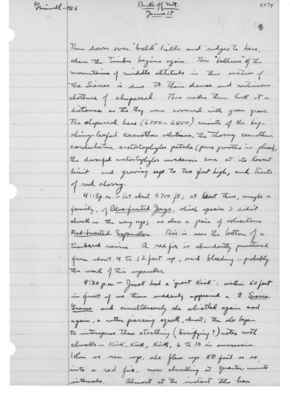Pages That Mention ravine
1925: Joseph Grinnell's field notes
S2 Page 4
Collector: Grinnell - 1925 Location: Lassen Section Date: June 12, 1925 Page Number: 2460
slopes of Inskip Hill); Calif. Woodpecker; Nuttall Woodpecker; Calif. Purple Finch (very common and in full song here in the black oaks); Linnet (equally common and in full song); Western Tanager (one in full song, as I write); Cassins Vireo and Western Warbling Vireo (equally in evidence); Wood Pewee (common); Ash-Throated Flycatcher ( "buckaroo" song heard early in the morning from slopes of Inskip Hill; Black-Throated Gray Warbler (several singing males); Lutescent Warbler (one singing male) Western Lark Sparrow (several); Western Chipping sparrow (common and singing); Green-backed Goldfinch (singing birds almost continually within hearing); Wren-tit (heard song from bushy slopes of Inskip Hill; Valley Quail (sentinel call of male in distance); Plain Tit (one pair, in black oaks); Slender-billed Nuthatch (very common); Bullock Oriole (one heard); Morning Dove (several have flown past); The "stream" right here is now dry - all the water taken out for the ranches around Payne Creek P.O. But down below here a few rods a narrow canyon begins, cut down thru the lava cap, and there, there are potholes with water, the source, apparently, for the birds of these woods. Along the ravine are luxurious golden oaks, densely blooming syringia (Philadelphus), ash trees, etc. Up in the rocky walls are bushes of Cercis and Rhus Trilobata.
S2 Page 19
Collector: Grinnell - 1925 Location: Lassen Section (Brokeoff Mt.) Date: June 17, 1925 Page Number: 2474
Then down over "bald" hills and ridges to here, where the Timber begins again. This "baldness" of the mountains of middle altitude in this section of the Sierras is due to their dense and continuous clothure of chaparral. This makes them look at a distance as tho they were covered with green grass. The chaparral here (6000-6500) consists of the big shiny-leafed ceanothus velutinus, the thorny ceanothus condulatus, arctostaphylos patula (pure growths in places), the dwarfed arctostaphylos nevadensis here at its lowest limit and growing up to two feet high, and tracts of red cherry. 4:15 p.m. - At about 6700 ft.; at least there, maybe a family, of Blue-fronted Jays, which species I didn't check on the way up; as also a pair of solicitous Red-breasted Sapsuckers. This is near the bottom of a timbered ravine. A red fir is abundantly punctured from about 4 to 12 feet up, and bleeding - probably the work of this sapsucker. 4:30 p.m. - Just had a "great kick": within 50 feet in front of us there suddenly appeared a female Sierra Grouse and simultaneously she whistled again and again, a rather piercing squall, almost; then she began to intersperse these startling (terrifying?) notes with clucks - kirk, kirk, kirk, 6 to 10 in succession. When we ran up, she flew up 80 feet or so into a red fir, now clucking at quarter-minute intervals. Almost at the instant the hen

